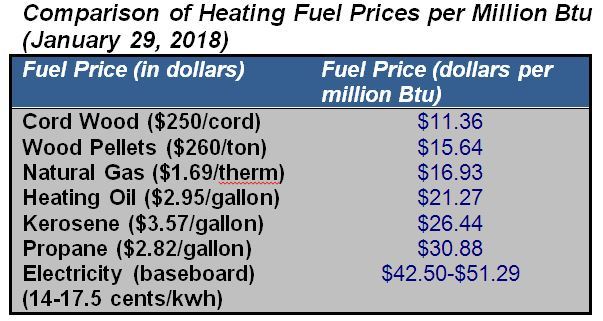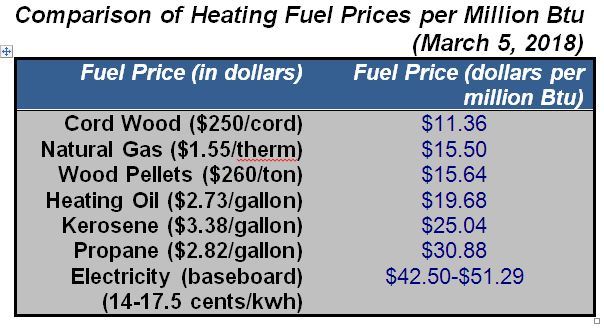Augusta, Maine – The Governor’s Energy Office (GEO) conducted its weekly heating fuel price survey on Monday, March 5, 2018, and found the current statewide average cash price for No. 2 heating oil was $2.73 per gallon, down 22 cents from the end of January, when prices peaked during prolonged, bitterly cold weather. The average statewide kerosene price has declined similarly over the last several weeks, and is now at $3.38 per gallon. The average propane price (for heating customers) has remained very steady over the same time period, at $2.82 per gallon for heating customers. See table below.

After rising to prices not seen in several years (between $65 and $70 per barrel in January), global crude oil prices declined approximately 10% in mid-February. Since that time, prices have fluctuated several dollars per barrel, and now are in the $63 (WTI) to $66 (Brent) rangehttps://oilprice.com/oil-price-charts/46. These fluctuations are due to several factors, global and domestic. In late 2016, OPEC (Organization of Petroleum Exporting Countries) members agreed to production cuts, in order to reduce excess global inventories that were keeping prices low (so low that some North American shale oil producers could not economically continue producing). During 2017, prices began to rise as the global oil glut eased, and continued rising due to weather events, such as Gulf coast hurricanes that knocked out refinery production, and prolonged, severely cold weather across much of the eastern U.S. in late December and January.
With higher global prices, however, North American shale oil production has begun increasing again; U.S. oil production has now reached record levels (over 10 million barrels per day). In addition, Libyan oil production has surged, placing further pressure on OPEC’s plan to limit an oversupplied global market https://www.bloomberg.com/news/articles/2018-03-05/oil-gains-as-output-from-libya-s-biggest-field-is-said-to-stop. The International Energy Agency (IEA) recently released a report stating that U.S. will dominate global oil markets through 2020, keeping the pressure on OPEC’s efforts to curb production and raise priceshttps://www.nasdaq.com/article/iea-predicts-nightmare-scenario-for-opec-cm930495.
Propane supplies and prices are the result of different factors, mostly domestic, but in the Northeast U.S., imports also influence pricing. Because propane is a by-product of U.S. shale oil and gas production, the amount of propane produced in this country has increased dramatically. This, in turn, has resulted in the export of significant volumes of propane, which has prevented domestic inventories from rising (and putting downward pressure on prices). In addition, in the Northeast, limited transportation options (no pipeline into the Northeast; less reliable rail transport), as well as increased demand during the peak heating season, sometimes results in the need for an influx of more costly imported propane. This is illustrated in the graph below.

A spike in demand during the late December/early January cold weather depleted the region’s inventories. More expensive imports were used to quickly replenish the area’s supply. Warmer temperatures over the last few weeks have contributed to inventories remaining well within the five year range.
Below is a table of prices collected for various regions of the state.

The following two tables compare the prices between various heating fuels, and converts these prices to a common heating unit value (dollars per million Btu). In January, when oil and natural prices were higher, wood pellets had a lower dollar cost on a heat value basis. This week, lower natural gas prices make this a lower cost fuel (on a strictly heat value basis).


However, fuel prices are only part of the calculation when determining which fuel will save you more money over the course of a heating season. The type of heating system, as well as its efficiency, is also an important factor in determining final costs. The Energy Office has a calculator on its web site that allows consumers to explore these fuel options further, as well as compare efficiencies of heating systems most closely matching their own system. Heating costs vary considerably from home to home. The home heating calculator can assist homeowners in finding the best heating option for their home, location, lifestyle, and budget http://www.maine.gov/energy/index.html. Efficiency Maine also has a calculator on its website that can help consumers evaluate their heating optionshttp://www.efficiencymaine.com/at-home/home-energy-savings-program/heating-cost-comparison/
The price for heating oil is a statewide average; prices in a given geographic region of the state may be considerably higher or lower than this average. This week, within the Energy Office sample, the highest heating oil price found was $3.00, and the lowest heating oil price found was $2.39. Also, the statewide average price for propane is based on consumption of at least 900 gallons a year. Households using propane just for cooking or hot water generally pay a higher per gallon price. The table above provides current Maine cash prices in dollars rounded to the nearest penny.

No comments:
Post a Comment